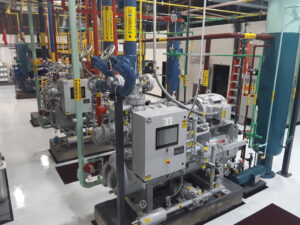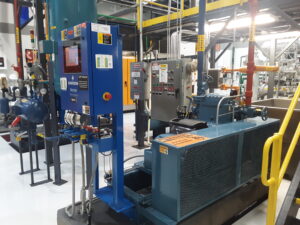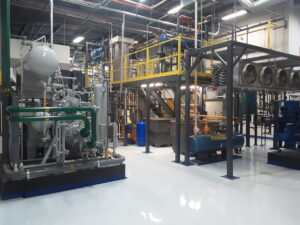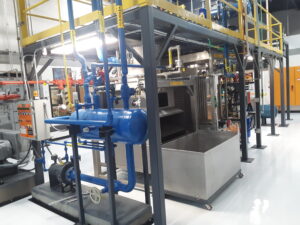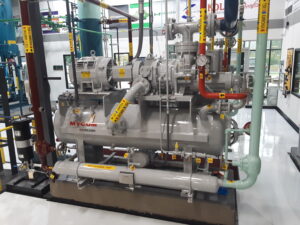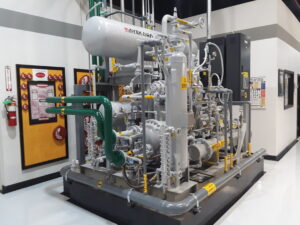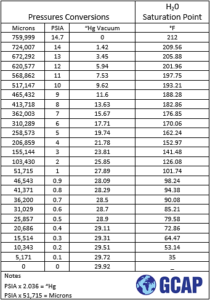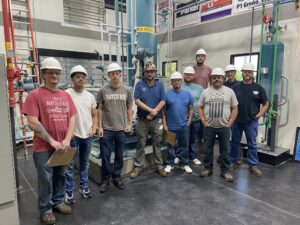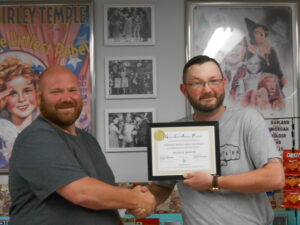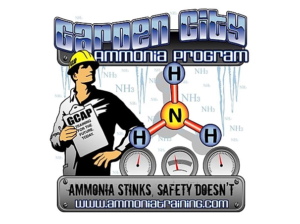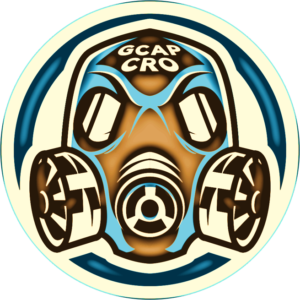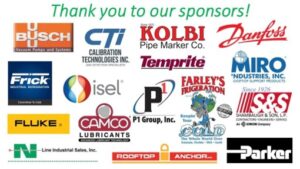News
Housekeeping and General Appearance – NH3 Machinery Rooms
by Jeremy Williams on Sep.10, 2020, under News
At first if you don’t succeed, try again. Definitely a big difference from the original black died concrete. Next project is diamond plate going up around all curbs!
Housekeeping is extremely important and a system that does not look well maintained most likely is not well maintained. Here are some things you can look for when entering a compressor room that has process equipment:
- The area should not have an ammonia odor
- The area should be well lit
- The area should be clean and free of debris, puddles, etc…
- The area should not be used for bulk storage
- The equipment and piping should be clearly labeled
- The equipment should be free of visible corrosion
- The equipment should be free of excessive ice build-up
- Ammonia detectors should be in working order and free of obstruction
- Air intake for ventilation should be clean and free of obstruction
- The safety shower/eye wash should be clean and the path to it unobstructed
- and much more…
“Hg – Microns – PSIA Conversions
by Jeremy Williams on Aug.07, 2020, under News
Properly dehydrating an ammonia refrigeration system after build or maintenance is essential to a water free refrigeration system. After all piping and equipment has been leak tested and proven tight one could would need to remove the residual pressure. If you desired to remove the water taking it to a “deep vacuum” is essential.
Connect a vacuum pump or a pump out compressor until 5,000 microns is achieved. At the beginning, pressure and micron count will drop quite quickly, however the more water in the system the reduction will gradually slow down. Any low spots may have liquid water settled and safely applying heat will help it boil away.
Once 5,000 microns is achieved and can be held relatively constant without any increase with the pump/compressor off, the system has been dehydrated and it is now ready bringing over the remaining ammonia or taking its first charge.
National Ammonia Operator Day!
by Jeremy Williams on Jul.17, 2020, under News
We at GCAP want to thank all personnel involved with the aspects of NH3 Refrigeration. Today we celebrate you on the 17th of July. Recognize Yourself!!!
Looking for small NH3 Leak
by Jeremy Williams on Jul.10, 2020, under News
Today walking through the engine room I got a faint smell of ammonia and today we have made a R-717 Video Tip to show how litmus paper can help find NH3 leaks. Ammonia leaks may be detected with the aid of litmus/Ph paper. Get the paper soaked in water and pass it around in the area in which you may think the leak is coming from. If the paper while wet with H20 comes in contact with NH3 it will change colors. Check out the training video below
Hard Work Will Always Pay Off
by Jeremy Williams on Jun.26, 2020, under News
We at GCAP are so proud of Micheal Shriver. He came, he conquered, and he passed the recent Ammonia Operator 1 Course all out of his own dime. Now all he needs is you. Are you looking for new ammonia operator. If so give the school a call @ 620.271.0037
Twin Screws and Direction of Rotation
by Jeremy Williams on Jun.10, 2020, under News
Jeremy Williams of GCAP brings to you another R-717 Video Tip of the Day. Today we talk and test the proper direction of rotation as we commission the new screw compressors at GCAP
What is Condensation?
by Jeremy Williams on Jun.03, 2020, under News
Today GCAP’s Online Training Resources brings your this free R-717 Video Tip of the Day is about what is happening inside a condenser?
Topics Include:
- Heat Transfer
- Controlled Explosions
- Controlled Implosions
- Condensation
- Pressure Reduction
How To Test High Level Floats
by Jeremy Williams on May.26, 2020, under News
If an ammonia refrigeration system incorporates a vessel on the low side and compressor is pulling off of or through, then it is suggested to high level protection and to at least test it annually. Today GCAP’s Online Training Resources brings your this free R-717 Video Tip of the Day on testing high level floats.
The website for posting a Blue Collar Job around Industrial Maintenance and Safety is
www.DreamCareer101.com
and our new facebooke page for job postings is
Blue Collar Jobs – Industrial Maintenance
Anhydrous Ammonia Burning
by Jeremy Williams on May.18, 2020, under News
Did you know that ammonia can burn? Pure anhydrous ammonia’s fuel rangeis accepted to be 15%-28% ammonia and remaining being air. This is 150,000 PPM – 288,000 PPM, way above life sustaining concentrations. Not all vendors/suppliers can agree to the flammability of the chemical. See below from these vendors recent SDS sheets.
We are excited to release today’s R-171 Video Tip of day “Can Ammonia Burn” presented by Jeremy Williams of GCAP.
Ammonia Refrigeration Systems and Anhydrator Vessels
by Jeremy Williams on May.12, 2020, under News
Anhydrous means lack of water, unfortunately ammonia is hydroscopic which means it loves water. Water can get in an ammonia system approximately six different ways and should be removed for several reasons. If more information on how it comes in and how to remove please see this post.
An anhydrator vessel is simply a batch process subcooler. If systems are pipe accordingly, they can also act as an oil still and/or a pump out accumulator. We hope you enjoy today’s R-717 Video Tip of the Day presented by Jeremy Williams and brought to you by Garden City Ammonia Program
